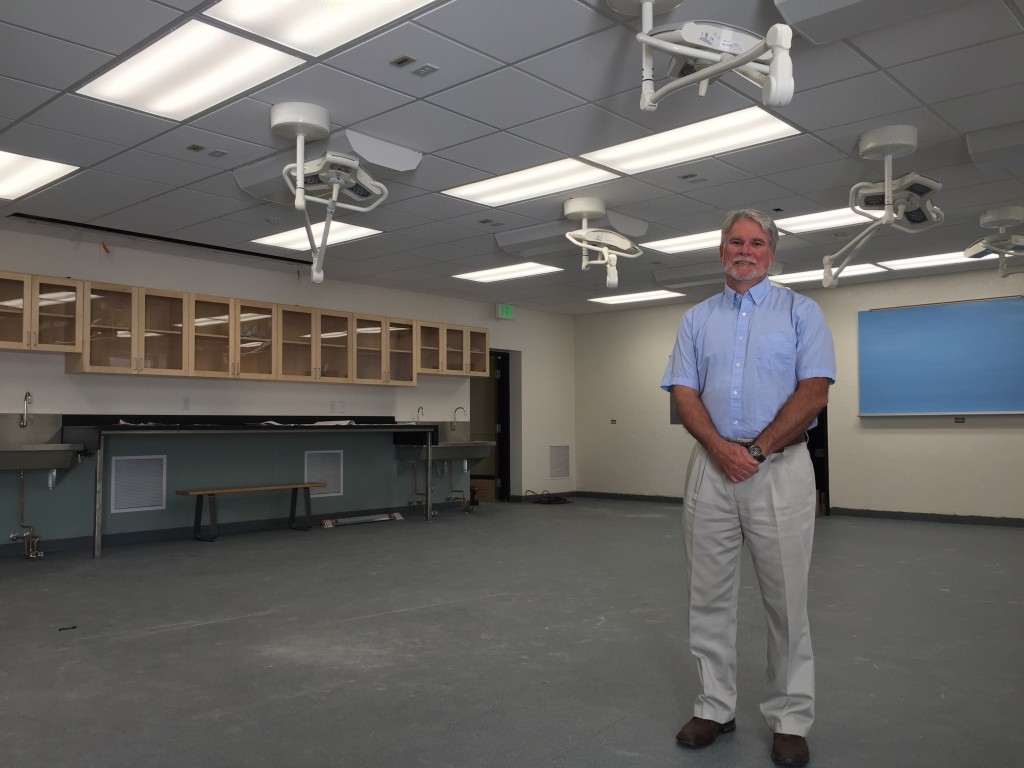$1 million upgrade to ISU Pocatello anatomy and physiology lab boosts learning opportunities
August 12, 2015
POCATELLO – A $1 million-plus anatomy and physiology laboratory upgrade and the installation of an $87,000 virtual dissection table will provide a major boost to the already exceptional quality of anatomy and physiology classes taken by hundreds of Idaho State University students each semester on the Pocatello campus.
Both projects are slated for completion by the start of fall semester.
The existing anatomy and physiology laboratory located in the ISU Gale Life Science Building was updated with new ventilation, heating, cooling and lighting, and was “completely gutted and remodeled” and has new ceiling tiles, flooring and cabinets. Its refrigerated area has been expanded and upgraded and now has the capacity to hold eight cadavers.

The $1.08 million funding for the cadaver laboratory improvements came from the Idaho Permanent Building Fund. Anatomy and physiology is a required course for many biological science and health professions students. More than 20 sections of undergraduate classes use the A&P laboratory each semester and it is used by a variety of other graduate and undergraduate courses.
“The complete overhaul and improvement of the A&P laboratory have modernized it and make it a much better space to teach students,” said Jeffrey Meldrum, ISU professor of anatomy and physiology. “Working with real cadavers in our A&P lab is a tremendous and valuable opportunity for our students and is an essential experience for them.”
In addition to the remodel and improvement of the A&P lab, ISU has purchased an $87,000 Anatomage Table that can be used for virtual dissections. The Anatomage Table is “billed as most technologically advanced anatomy visualization system for anatomy education.” Two of these tables have also been installed in the L.S. and Aline W. Skaggs Treasure Valley Anatomy and Physiology Laboratories at the ISU-Meridian Health Science Center.
This “all-in-one, touch-interactive” 3-D display system represents a joint effort between the ISU Division of Health Sciences Physician Assistant program and the ISU College of Science and Engineering’s Department of Biological Sciences. The Physician Assistant program purchased the table that will be housed and managed by the ISU biological sciences department. The Idaho Dental Education Program at ISU and the ISU Department of Physical and Occupational Therapy are also contributing resources to this project.
“The Anatomage Table will be extremely valuable to physician assistant students, but we’re also happy to support biological sciences for all the support that department offers the Division of Health Sciences,” said Paula Phelps, program director of the Department of Physician Assistant Studies.
Although ISU professors stressed that a virtual anatomy laboratory cannot replace working with a real cadaver, the use of the Anatomage Table can enhance and augment learning. The Anatomage Table will display true human gross anatomy in real-life size. Anatomage users can virtually dissect a human cadaver or animal and examine its muscles, tissues, organs, bones and other structures in 3-D and 4-D.
“In addition to this instrument providing a state-of-the-art anatomy teaching tool, it will also provide an excellent resource for local high school students that routinely tour the biological sciences department as well as an opportunity to engage the local health and medical community,” said Mark Austin, chair of the ISU biological sciences department.
ISU’s Anatomage Table comes with a human anatomy digital library module that includes more than 120 pathological examples of diseases or conditions, and a dental anatomy digital library with scores of pathological examples, that allow students to not only dissect normal gross anatomy, but also experience abnormal pathologies, such as examining a bone fracture or type of cancer. Anatomage also has interactive 4-D scans that can be used to visualize respiration and beating heart scans . The Anatomage can also be connected to projectors to enhance lectures, or its images can be broadcast to other locations.
“It doesn’t replace a cadaver experience, but it is a valuable supplement to it,” said Curtis Anderson, ISU biological sciences professor who is managing the installation of the Anatomage on the Pocatello campus.
Categories:
